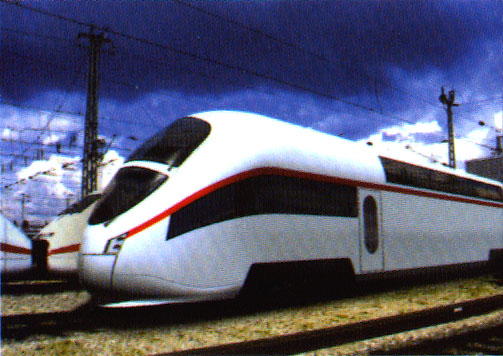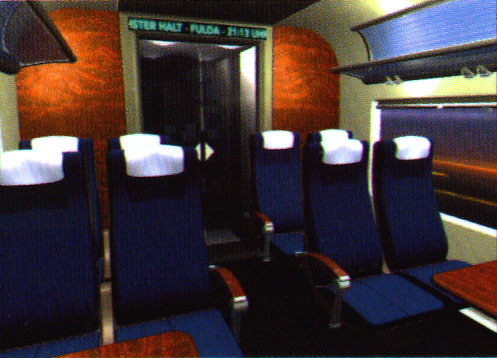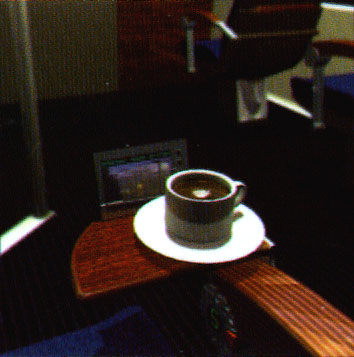ICE 4
Possibilities for the successor of the ICE 3
ICE 4 is the name of the optional 50 trains that the DB AG has ordered
from the ICE 3 consortium.
At first, two different high-capacity versions were considered:
- A double deck version similar to the French TGV Duplex or
the Swiss IC 2000. DWA (now part of Bombardier) started developing
such a train.
- A wide-body version with five seats abreast in second class and four
in first class, technically very close to the ICE
3. This is clearly derived from the Japanese Shinkansen trains,
which also have wide carbodies and very high seating capacity.
However, operating the wider version would only be possible on a few
dedicated lines with wider clearing (the currently existing high-speed
lines, some upgraded lines and possible future lines), and the 3+2 seating
arrangement is unpopular among the passengers. A bi-level train would probably
be heavier and have space problems. Both versions would need to be a
completely new development again, with costly and time-consuming design
and experimentation period. Therefore it seems more likely that the ICE
4 will be based on the ICE 3 carbodies.
The tilting ICE
It is now very probable (though they have not yet been ordered) that 45
units of an ICE 3-N with active tilting system will be built
from 2002 on (not to be confused with the ICT,
which is primarily for old lines). This train is designed for lines that
consist of both high speed sections and old, curvy lines - the majority of
ICE lines today. It will be able to travel at higher speed on all
lines. A modification of the ICE 3 carbody is not necessary
because it is already narrow enough not to exceed the clearance when
tilted.
High capacity options
During a TV show in spring 1999, Johannes Ludewig, the chairman of the
Deutsche Bahn AG, has brought the double-deck ICE back into the
discussion, as a possible solution for highly occupied lines. Rumours say
that there might be a call for tenders for such a train in 2000 or 2001.
These pictures show a proposal by DWA/Bombardier and IFS-Designatelier from
1997 for a double deck "ICE 4 DD":



In this concept, the end cars have transformers and inverters in the lower
deck. The middle cars are partly articulated (two carbodies on three bogies).
The ICE offer for Spain
For the high speed line Barcelona - Madrid in Spain (350 km/h top speed),
three types of rolling stock are being offered:
- The Talgo XXI by Patentes Talgo and Adtranz
- A TGV variation by Alstom
- A version of the ICE 3 by Siemens

Further possibilities for future ICE versions
The ICE has still some potential for weight reduction. One way towards
this would be an articulated train composition with fewer wheelsets. The
aluminium carbody could be replaced by compound materials. It is desirable to
lower the floor so that the entrance becomes more comfortable even from low
platforms - this implies alternative solutions for wheel arrangements as the
wheel diameter can't be reduced much. The heavy transformer poses a great
problem in these articulated concepts with distributed drive technology, so
engineers are seeking for more leightweight solutions - for example, the
frequency could be changed to several kHz before transforming.
The ICE 21 project (see picture) was originally planned for testing
such elements, but the industry and the DB AG dropped the project for now as
no agreement on the funding could be found. It seems that for the next years,
all ICE versions will be derived from the ICE 3 in some way.







